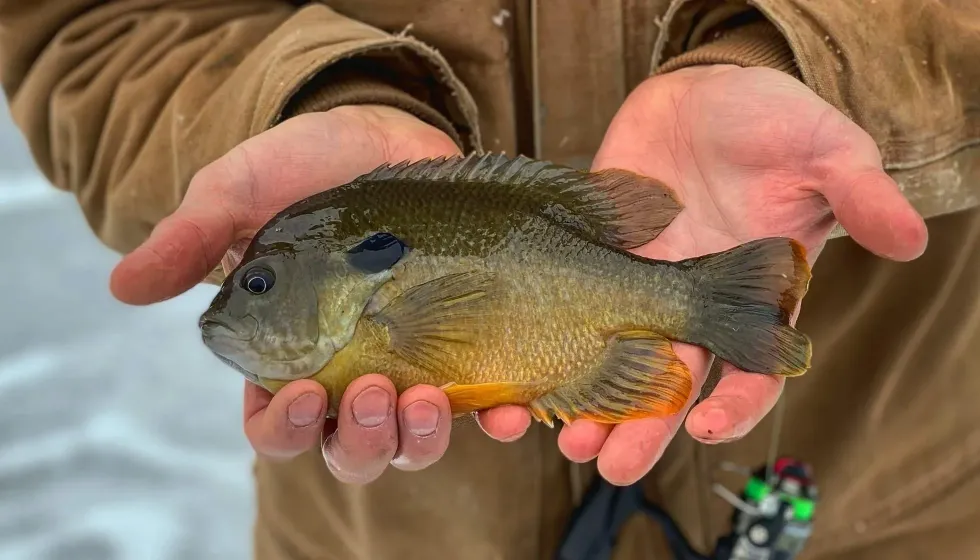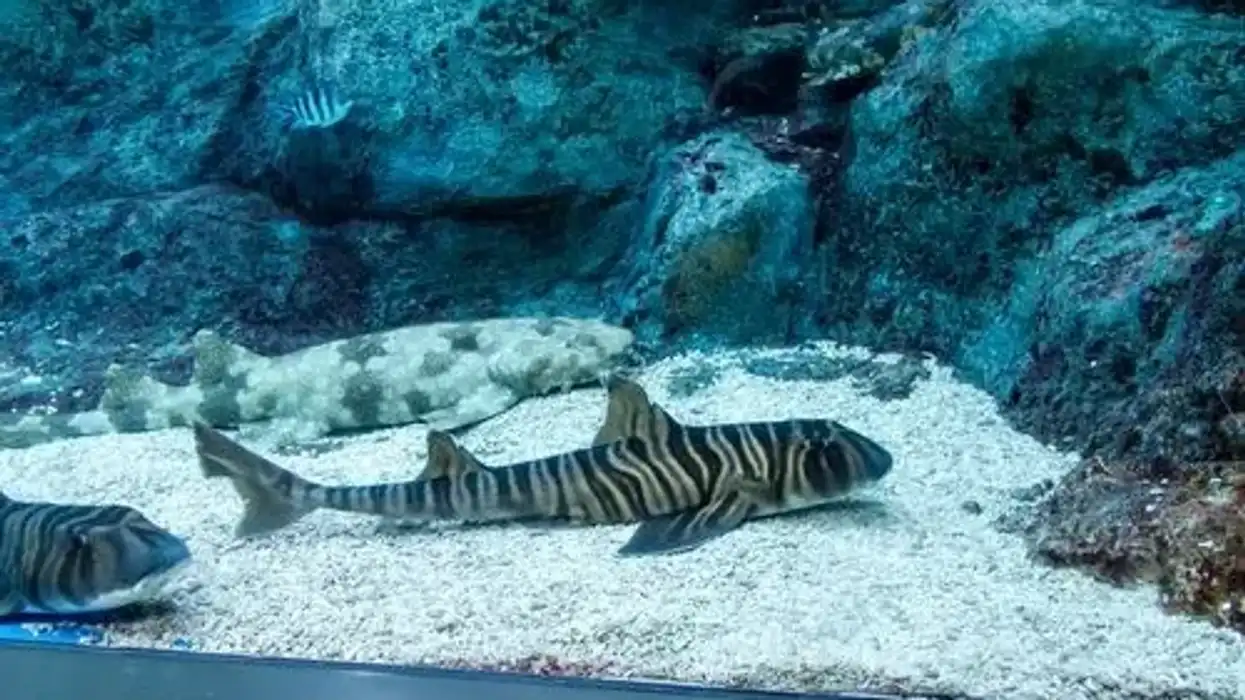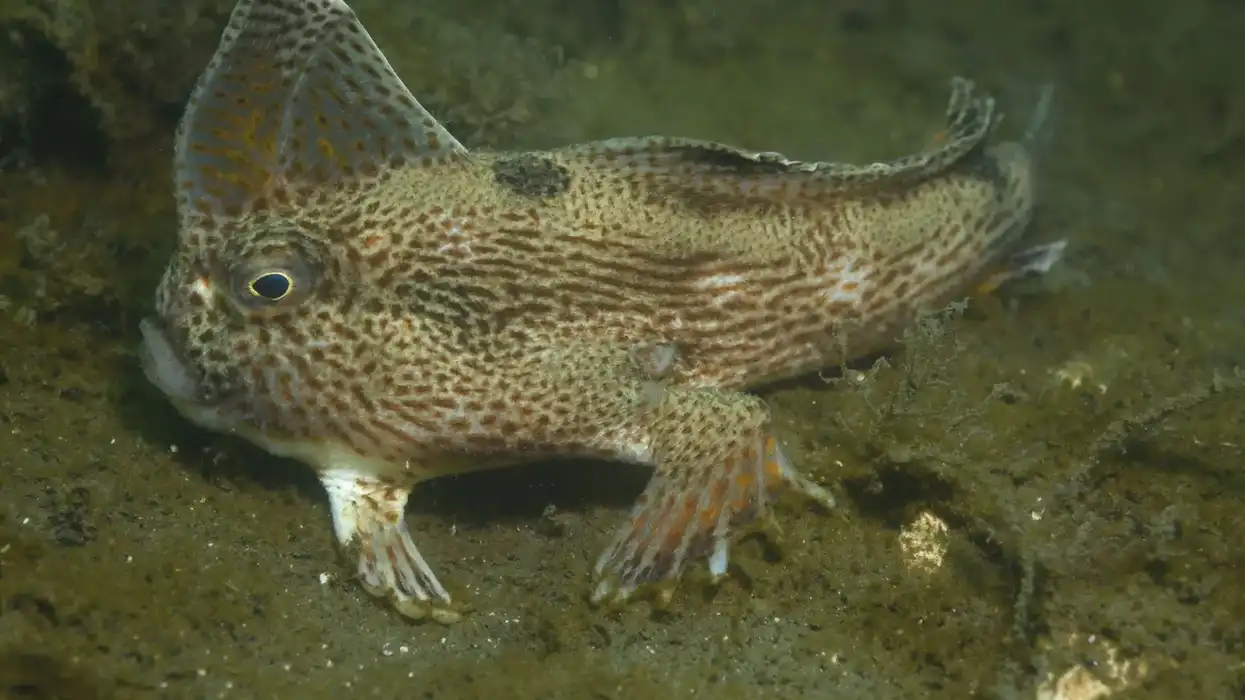Mud sunfish (Acantharchus pomotis) are freshwater fishes and they are a member of the sunfish family Centrarchidae. They have a compressed body with rounded tail-like anal fin, caudal, short muzzle, large eyes, and mouth.
The side of the head has three to four parallel black to brown stripes across and has an enlarged upper jaw under the eye. Mud sunfish can be found in sloughs, swamps, pools, lakes, and in the backwater of a small to medium creek and river.
Mud sunfish are usually found near aquatic vegetation helping them to navigate under the water being hidden. This species is widely distributed across North America, particularly in South Carolina.
Mudfish is the monotypic species of the genus Acantharchus. They are nocturnal in nature and like to spend their time during the day hidden under the detritus and mud, and come out of their hiding place to search for food during the night.
If you liked these facts about mud sunfish, then check out fangtooth moray eel and yellow tang too.
Mud Sunfish Interesting Facts
What type of animal is a mud sunfish?
Mud sunfish (Acantharchus pomotis) are freshwater ray-finned fish and they belong to the order Perciformes. They have brown eyes and a round tail fin with pale brown belly and reddish-brown body color on top. Apart from mud sunfish, other popular species of sunfishes include green sunfish, redear sunfish, and redbreast sunfish.
What class of animal does a mud sunfish belong to?
Mud sunfish (Acantharchus pomotis) belong to the class of Actinopterygii and are ray-finned fish. Actinopterygii is divided into two different classes Cladistia and Actinopteri. Actinopterygians comprise almost 30,000 species of fishes including piranhas.
How many mud sunfish are there in the world?
Unfortunately, there is no accurate count on the population of the mud sunfish (Acantharchus pomotis). As this species is easily available and bred in private aquariums, it is impossible to know the exact population.
Where does a mud sunfish live?
Mud sunfish (Acantharchus pomotis) population distribution occurs along the eastern coastline of the United States and are widely distributed in North America from New York State to northern Florida, Georgia, and South Carolina.
This sunfish is very common in New Jersey and Florida lowland streams, coastal plains, and any area of wet muddy ground that is too soft to support the heavy body.
What is a mud sunfish's habitat?
The favorable habitat for a mud sunfish (Acantharchus pomotis) includes dark sluggish, stained, vegetated creeks, small to medium-sized lakes, rivers, swamps, and ponds with detritus or mud.
The mud sunfish prefers acid waters integrated with pine barren regions and cedar swamps. Also, they like still water with the large development of aquatic vegetation.
Who do mud sunfish live with?
The mud sunfish (Acantharchus pomotis) is by nature a schooling fish. It is found in a group of six or more and because of their peaceful nature, they can live with other species.
How long does a mud sunfish live?
A fully grown mud sunfish's (Acantharchus pomotis) lifespan is a maximum of eight years, but with proper care and diet, this species can live longer in aquariums. Just like other species of fish, a mud sunfish's lifespan can be affected by the level of care and diet it receives.
They can be found in water bodies such as a rivers and lakes.
How do they reproduce?
The breeding season of Acantharchus pomotis (mud sunfish) occurs during the spring season and this species of sunfish reaches their sexual maturity at the age of one year old.
Cannibalism of eggs is extremely common in this species and if they are breeding in captivity, you should take both the males and females out of the breeding tank as they might eat the eggs.
After the female lays eggs, the male will fertilize the eggs externally and stays near the nests until the fry disperses.
What is their conservation status?
The IUCN Red List has listed these fish as a species of Least Concern as their conservation status. These species are globally recognized as a quality addition to the aquarium school. This species is bred in captivity and has a vast population distribution across North America.
Mud Sunfish Fun Facts
What do mud sunfish look like?
Mud sunfish (Acantharchus pomotis) are freshwater ray-finned fishes and they can be easily recognizable because of their five to six spines on the anal fin with almost 15-gill rakers.
It has a compressed body with a rounded tail-like fin and caudal fin, a short muzzle, large eyes, and a large mouth. The side of the head has three to four parallel dark brown to black stripes across and has an enlarged upper jaw under the eye.
They are pretty small in size growing up to a total length of 5-8 in (13-21 cm).
Female mud sunfish are larger than males with a rounder body. Male mud sunfish are smaller and more slanderous than females with larger dorsal and anal fins compared to females.

How cute are they?
Acantharchus pomotis (mud sunfish) are friendly creatures that tend to live peacefully among tank mates and are considered cute. Mud sunfish are active swimmers and need sufficient aquarium space. With the compressed body shape, larger mouth, and spines on the circular tail, they attract many breeders to be kept as pets.
How do they communicate?
All fish have otoliths consisting of a sensory epithelium made up of calcareous otoliths and their hair cells that they used to communicate with each other.
How big is a mud sunfish?
Mud sunfish (Acantharchus pomotis) are relatively small in nature and reach a maximum adult size of 5-8 in (13-21 cm) in length all through their life.
How fast can a mud sunfish swim?
Mud sunfish are schooling fish that swim in groups for a large part of their life moving delicately and quickly around the fish tank. This species of fish are fast swimmers and bottom dwellers spend their time near dark sluggish muddy waters.
How much does a mud sunfish weigh?
Unfortunately, no data is available about the weight of mud sunfish as they are the only species of the Acantharchus genus. This species can grow only up to a maximum size of 5-8 in (13-21 cm) in length and are relatively smaller fish in the aquarium.
What are the male and female names of the species?
Mud sunfish belong to the family Centrarchidae. However, different names for males and females of this species are not given.
What would you call a baby mud sunfish?
A baby mud sunfish is known as fry, just like all other species of baby fish.
What do they eat?
Mud sunfish primarily search for food during the night and they feed on crustaceans and small aquatic insects, but larger individuals may prey on small fish.
Are they poisonous?
Mud sunfish are not poisonous at all.
Would they make a good pet?
Yes, mud sunfish will make an excellent pet as they can easily be accustomed to any environment and it is easy to create an artificial habit for them.
Not much experience is required for keeping them as pets. Mud sunfish are active swimmers and they need a large tank, the size should be at least 15 gal (57 l) for them to swim around.
While breeding, we should always take the males and females out of the breeding tanks for the safety of the eggs as cannibalism of eggs is common among this species as they might eat their own eggs.
Mud sunfish prefer sluggish muddy waters, so the aquarium should have a proper flow of running water with artificial muddy beds. Mud sunfish are a conventional species in the aquarium population. This species is easily available in pet stores because of its vast popularity and ease to raise in captivity.
Did you know...
The mud sunfish gets its name from its habit of hiding along the muddy bottom of creeks, rivers, and lakes during the day.
The ear of a sunfish is really not an ear because it is an extension of the gill cover that varies in color from species to species.
The scales of mud sunfish are the most interesting physical feature as it is the only member of the sunfish family that has cycloid scales.
This fish is also known as Centrarchus pomotis (Baird 1855) which is a synonym of their scientific name.
The bluegill (Lepomis macrochirus) is a freshwater fish and it is a member of the sunfish which is why it is called sunfish. The bluegill also belongs to the family Centrarchidae and is endemic to North America.
This species lives in rivers, streams, ponds, and lakes and their population distribution occurs across the coastal regions of North Florida and Georgia.
How big do sunfish have to be to keep?
Mud sunfish (Acantharchus pomotis) can grow up to 5-8 in (13-21 cm) throughout their lifespan and are an easy pet to keep. Here are some tips and tricks for taking care of mud sunfish as a pet:
Step 1: This species needs a larger aquarium of at least 15 gal (57 l) as they love to spend their time swimming.
Step 2: A mud sunfish tank needs dark sands, gravel, or detritus for the bottom to make it similar to its natural habitat. They live in a school of six or more.
Step 3: Place rocks, artificial caves, and driftwoods for them to hide in as this fish comes out at night.
Step 4: Place taller plants as this species lays eggs on the bottom of aquariums.
Step 5: This species can become accustomed to all conditions, but to keep them healthy and make them live longer, you need to maintain proper water conditions as they are freshwater fishes and their natural habitat is easy to recreate.
Step 6: Provide them with a good diet that consists of high-quality live foods and flack foods.
How many eggs do mud sunfish lay?
A pregnant mud sunfish (Centrarchus pomotis (Baird 1855)) spawn at intervals spreading the eggs in several nests in their natural habitat laying almost 10,000-160,000 eggs depending on the length, size, and age. Their eggs will hatch in 24-36 hours and the young fry will initially feed on the egg sac.
Here at Kidadl, we have carefully created lots of interesting family-friendly animal facts for everyone to discover! Learn more about some other fish from our Nassau grouper facts and red grouper facts pages.
You can even occupy yourself at home by coloring in one of our free printable mud sunfish coloring pages.










